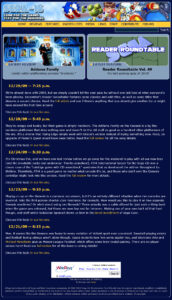Sega-16 Year 20 Retrospective – Sega-16 (original) (raw)
20 years ago, I planted my flag online to create my own little corner of the Internet. I knew I wanted to build a website, but I knew nothing about coding, and I wasn’t even sure what kind of site I wanted. At first, the idea was to start one devoted to the TurboGrafx-16, a console I love dearly. It had little online representation at the time, so it was an ideal candidate. After mulling it over for a while, I decided that the Sega Genesis would be a better candidate, as it was not only my favorite console of all time but also woefully underrepresented.
Version 2 of the site was much cleaner and professional.
So, there I had the theme for a potential website. All I needed now was a hook. I didn’t want to do the same game lists or simple, one-paragraph reviews of some other sites. I wanted to do something that no one else was doing, something special. I was very much interested in the stories behind the games I loved in my youth, the people and the events that went into their creation. The power of the Internet gave me the opportunity to contact many of the people involved, so why not talk to them? Why not get the stories behind the making of those classic titles? I could talk to executives, programmers, artists, and anyone else willing to share their experiences making Genesis games. I didn’t know if any of them would respond, but there was no harm in trying. It turned out that the overwhelming majority were receptive to my contact and even provided resources I could never have expected, like design documents, images, and even contacts to other people I couldn’t otherwise reach. I could complement those interviews with retrospectives, long-form reviews, and other comprehensive articles that could serve as a resource for old and new gamers alike, as well as an archive for researchers. No other site was focused on this aspect of Genesis gaming, so it seemed to be the perfect pitch.
There was only one problem: I knew nothing about coding websites. At the time, resources like WordPress didn’t exist, and everything had to be done by hand. So, where to start? It was at a series of faculty workshops that I got my answer. As part of a session on creating online content, we were given a CD-ROM with the Macromedia Suite that contained the HTML editor Dreamweaver and the image editing program Fireworks. I took that as a sign. I bought a book on basic Dreamweaver use and HTML for Dummies and set out to make my website dream come true. I spent hours each day experimenting with different buttons, features, frames, and links to make the site as functional as possible. After a few weeks, it was finally ready to go online…
… and it looked like utter garbage.
I mean that. It was FUGLY. I knew that going in, and the plan was to compensate for the ghetto look with excellent content. Slowly but surely, as the articles were published, I attracted readers, but most surprisingly, I also attracted contributors! It was never my intention to have others write for the site, but I was happy to have the help, and it was wonderful to see others with the same enthusiasm for the Sega Genesis as me. The website came to life and eventually saw a redesign, followed by the migration to WordPress in 2011. Through it all, we had a dedicated team of contributors and even, for a while, staff, who produced great content for our readers. I want to thank them all – Sebastian Sponsel, Nick Gibson, Vince Thornburg, Doug Jackson, Tom Briggs, and everyone else. Thank you for all your support. And to Rodger Swan, we miss you, pal. You’ll forever be in our hearts.
In 2008, we added SG-1000, Master System, and Game Gear coverage, and that was followed a few years later with the Saturn and Dreamcast. Time passed, I was able to channel my writing experience and connections into a book, Playing at the Next Level: A History of American Sega Games that was followed by three more (with another on the way!). All of this was way beyond my wildest dreams. Never did I think that it would go on for 20 years, but it has.
Things are different now. The contributors are gone, and there’s no staff. Sega-16 is back to being a one-man show, and that’s fine. That’s how it started, and I never expected people to stick around forever. The site is my life’s work in gaming, not theirs, and I’m happy and thankful for them taking time out of their lives to stop and help me for a while.
The Internet is also different. People tend to prefer videos over articles, and the term “content creator” seems to only apply to those who make videos or stream. I have nothing against Youtubers or streamers; they do some great work. Sega Lord X and Strafefox make incredible content. Still, even after the rise and dominance of YouTube, Sega-16’s niche remains mostly unmatched. Most videos don’t cover the same content we do and even fewer do so in the same depth, and I still think that there’s a need for that kind of coverage. We aren’t a news outlet, and our focus has always been the historical documentation of Sega’s hardware legacy. For that reason, Sega-16 will stick around, hopefully for another 20 years.
Rodger was a great writer and friend to the site. We miss him dearly.
The site is in a great position to do so, too. We’ve moved to professional hosting, putting an end to our technical difficulties. We no longer have to worry about server upgrades or security issues, as those were difficult to maintain with an all-volunteer group. We may not be publishing at the breakneck pace of 10 years ago, but the articles are still flowing, and hopefully, people are still reading them. As of this writing, we have consistently published at least one article a month for 20 consecutive years, not an easy task when you don’t have a paid staff. I’ve always written at my own pace, and as long as I can produce content regularly, I’m happy. I don’t know how many people actually read our stuff; I don’t look at the analytics to avoid the same trap a lot of the aforementioned Youtubers fall into regarding views. Once you’re a slave to the algorithm, creativity often takes a back seat. I want to avoid that.
Our forum has been moved and upgraded as well, and we’re on the most recent version of vBulletin’s software and with professional technical support. Forums are not easy to run as they used to be (remember when we first started with Invision Power Board?), which is something a lot of people out there don’t realize. Many think that you just snap your fingers and things get done automatically. vBulletin is expensive and complex, and without professional hosting it can be extremely difficult to maintain if you aren’t skilled in the software (which I am not). I know a lot of people were mad about the forums being down, but there were a lot of technical issues that needed to be resolved, and believe it or not, I do have a life outside the site. People often expect instant results and get mad when things don’t get resolved quickly, but if you follow our social media (and you should!) you saw that I posted regular updates about the progress of upgrade since we started taking donations in February. When you’re on someone else’s server and you have to wait for vBulletin’s tech people to evaluate your situation, it can take a while. After an evaluation, we were forced to go with vBulletin Cloud hosting when it was determined that our host’s server wasn’t compatible, and that extended the process a bit.
I still believe forums are the superior place for discourse and prefer them to Discord. Forums are more open and accessible, indexed for web searches, and just seem more navigable for finding information. Discord definitely has its place (we have one!), but to me, the forum will always be the place for chatting about games. Moreover, ours has been around for almost as long as the site, and it has an incredible history that deserves preservation. I’d like to thank Nick for hosting both the site and the forum for almost 15 years, giving Sega-16 a home and helping to keep it running for so long. He’s been a vital part of the site’s longevity, and I greatly appreciate his help and understanding.
So, if you’ve stuck around to the end of this rant, let me just thank you. Thank you for reading and coming with us on this journey to document Sega’s hardware legacy. Thank you for your feedback, your article contributions, donations, and every other means of support that have allowed me to live this writing dream for two decades. You have kept me going, and I am forever grateful. After almost 2,000 articles, including almost 200 interviews, Sega-16 is far from done. There’s still a lot of writing to do, and I don’t have any plans to stop any time soon.
SEGA!

